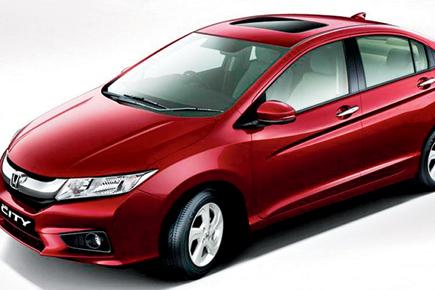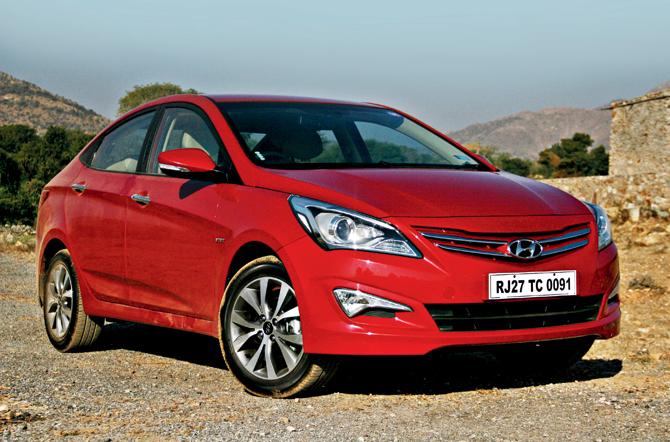Refreshed design, more features and a new 4S badge — is the new Verna geared well enough to take on its nemeses?

Honda City
The car that gave the unshakeable Honda City a solid run for its money — making it irrelevant, even, for a brief period, is back in its newest avatar. The 2015 mid-life update for the Hyundai Verna is aimed to bring some sparkle back to the sales of the Korean nameplate, also known as the Solaris in some other markets. In the meantime, the Ciaz from Maruti Suzuki has emerged as a force to reckon with, and the City has transformed into a better-rounded car than ever. So does the new Verna have the goods to take on such formidable nemeses? Let’s find out..

Price Rs 7.7-12.2 lakh
ADVERTISEMENT
Design and styling
The new Verna retains the overall proportions and size of its predecessor. A lot has changed if you look at the details though. Up front, the radiator grille has been totally reshaped — the horizontal single slat grille gets replaced with twin slats, flanking the Hyundai logo. The angular, hexagonal shape of the front grille housing has now metamorphosed into a more organic, curvy shape.
The headlights are new, too, featuring a projector setup encased within a satin silver barrel. There are plenty of chrome elements within the headlamp housing to add some detail. L-shaped fog lamps have been replaced by a boomerang design. On the sides, the Verna 4S looks almost exactly the same as the car it replaces, except for the new wheels. The new design 16 inch alloys feature a diamond cut design and look rather sporty.

No AC vents for the backseat. Strange, as even the smaller Grand i10 has this feature. PICS/AMIT CHHANGANI
At the rear, the tail-lights have been restyled, too, and now have an even more striking LED-like luminance. The rear bumper has also been restyled and now features reflectors which mimic the boomerang design of the front fog lamps. The Verna lettering has also been shifted from right to the left. The vacated space is now occupied by the details about the engine and the variant. Overall paint quality and finish remains excellent, and the Verna, as always, comes across as a premium product.
Interior and features
The Verna has always led the segment in terms of features. The Verna 4S carries over all the goodness of the model it replaces while incorporating some new features at the same time. The quality of the materials used and the workmanship is arguably segment-leading. All the buttons are made of soft-to-touch plastic and offer great feel and feedback. The Instrument cluster features two chrome-ringed white dials with multi-information display unit in the centre. Information on offer is generous and includes distance to empty, average and instantaneous fuel efficiency, ambient temperature, and tell-tale lights. The display also prompts you to shift gears to ensure better efficiency and optimum engine performance.

The new design has 16-inch diamond cut alloys
While the Verna doesn’t boast the biggest cabin in its class, there are plenty of storage spaces within the fuselage. The glove box, for example, is quite large and is also cooled via a small AC vent. There’s a sun-shades holder on the roof below the front cabin lights. There are bottle holders in all four doors, the space under the front arm-rest is quite decent, while the rear arm-rest features a cup-holder. There are twin cup-holders up front as well, and a small cavity which can hold your phone. Boot space, at 490-litres, is not class leading, but can easily swallow the luggage of a small family for a weekend getaway. The Verna 4S comes with a full-size spare wheel, which is a steel unit.
External mirrors fold electrically while the internal rear-view mirror is electro chromic unit that also incorporates the screen for the rear-view camera which works alongside parking sensors. The front passenger seat now has a lever on its side to allow the rear passenger to slide it for more legroom. Head, shoulder and leg-room, though decent, is not as good as some other cars in the segment. The rear seats could probably also have done with some more under thigh support. Also missing from the list of desired features is a rear AC vent. The omission is surprising, as even the basic Grand i10 boasts the feature.

Front passenger seat can be moved fore and aft by the rear passenger using the new lever
The infotainment system is a non-touchscreen unit. Playability and sound quality is great, though. Apart from allowing you to play audio through a variety of sources, the system also features an in-built memory of 1GB to let you store your favourite songs.
Performance
Like its predecessor, the Verna 4S come with the widest choice of engines in the segment. The four engine options on offer include two petrol and two diesel mills. Petrol power comes in the form a 1.4-litre, or 1.6 litre normally aspirated units. Power and torque outputs from the engines are rated at 106 bhp @ 6,300 rpm / 135Nm @ 5,000 rpm and 121bhp @ 6,300 rpm / 125 Nm @ 5,000 rpm respectively. Both engines are mated to a 5 speed manual transmission. The ARAI rated duel efficiency for the two engines is 17.43 and 17.01 kmpl respectively. The 1.6 petrol also comes with the option of a 4-speed automatic, with an ARAI certified fuel efficiency of 15.74 kpl.

Dashboard largely remains the same. We would have liked the inclusion of a touch-screen infotainment unit
Diesel power comes in the form of 1.4 and 1.6 litre Crdi engines dishing out 89 bhp @ 4,000 RPM / 220 Nm @ 1,750 RPM and 126 bhp @ 4,000 RPM / 259 Nm @ 1,900 RPM respectively. Both engines are matched with a 6-speed transmission for efficient highway cruising. The fuel efficiency rating for the 1.4 diesel stands at 24.8 kmpl while the 1.6 diesel delivers 23.9 kmpl to the litre. The 1.6 diesel engine also comes with the option of a 4 speed auto transmission.
Both petrol and diesel engines in the 1.6 liter guise deliver segment topping power and torque outputs. The petrol engine, though not an overly rev happy unit, delivers useable performance and makes for effortless, efficient driving, with the butter smooth transmission adding to the breezy experience. The 1.6 litre diesel engine is a punchy unit, though there is some turbo lag to be experienced below 1800 rpm. You feel the surge of the torque as the tacho needle swings past 2000 clicks, and thereon the diesel burner can take you some unusually high speeds. The diesel engine isn’t the best unit for stop start city driving, but exhibits admirable overtaking capabilities on the highway.
Ride and handling
The previous Verna, though a very feature rich car, was somewhat marred by lacklustre handling. Hyundai have tried to make the new Verna a more dynamically accomplished car by firming up the suspension. The overtly spongy ride which felt nice at low speeds, but was unnerving at higher speeds has been stiffened up for a more reassuring feel once you cross triple digits. Hyundai has also taken measures to ensure that harsh bumps encountered at higher speed don’t translate into a thud inside the cabin.
Even with its relatively better composure, though, the new Verna has some distance to go before it tries to match its German and Czech counterparts which are the segment benchmarks when it comes to dynamic ability. The Verna 4S is still somewhat edgy when pushed hard and at high speeds, the dips or crests on the road still manage to unnerve it. The behaviour of the 1.6 diesel variant, thanks to the added weight of the engine, however, is more composed as compared to its petrol counterpart.
The steering weighs up with speed, though like most new cars, the feedback isn’t quite there. We could have also called for a bit more precision and a bit less body roll while negotiating corners. Hyundai, however, need to be given full marks for equipping the Verna 4S with the best in class safety features. The top end variants come equipped with 6 airbags and ABS is standard across all variants.
Our verdict
The Verna has always been a stunner as regards to styling, even more so, in its newest avatar. The competition may have grown in size, but the Verna still manages to offer segment leading features, especially on the safety front. Loaded with a quality interior, great equipment and style, the Verna excels at many things. Outright dynamic ability is something which still has some margin for improvement, though this Hyundai is all the car you need on an everyday basis. Backed by the trusted Hyundai service network, the new Verna 4S offers itself as a genuine contender for the segment.
Technical specs (Hyundai Verna 4S)
Engine — 1.4 petrol/ 1.6 petrol/ 1.4 diesel/ 1.6 diesel
Power — 106 bhp @ 6,300 rpm/121 bhp @ 6,300 rpm/89 bhp @ 4,000 RPM/126 bhp @ 4,000 RPM
Torque — 135 Nm @ 5,000 rpm/125 Nm @ 5,000 rpm/220 Nm @ 1,750 RPM/259 Nm @ 1,900 RPM
Fuel efficiency — 17.43/17.01/24.8/23.9 kmpl
 Subscribe today by clicking the link and stay updated with the latest news!" Click here!
Subscribe today by clicking the link and stay updated with the latest news!" Click here!







